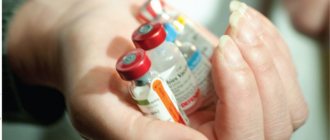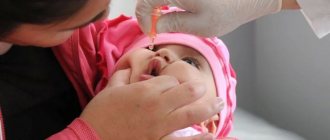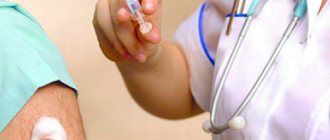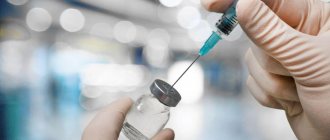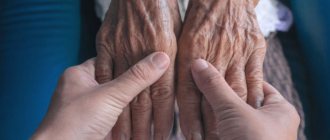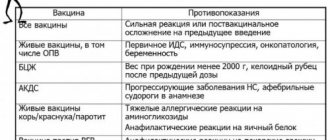Indications for use
Rabies vaccine is an immunobiological drug. It is included in the mandatory vaccination program for the population, and is also effectively used for bites of animals suspected of rabies, preventing the development of the disease.
The following groups of citizens are required to be vaccinated against rabies:
- Veterinarians and veterinary clinic workers;
- Gardeners and summer residents;
- Employees of laboratories and research centers who are in direct contact with animals;
- Persons working with stray animals, including those involved in catching them and keeping them in nurseries;
- Persons engaged in hunting and working in the forestry sector;
- Professional taxidermists;
- Researchers researching the rabies virus.
Rabies vaccination is recommended for both adults and children. Children are vaccinated between the ages of 1 and 5 years in the anterolateral part of the thigh, deep into the muscle tissue. For adults, the rabies vaccine is injected into the deltoid muscle of the back.
Kokav Rabies vaccine culture concentrated purified inactivated (Cocav)
The contents of the vaccine ampoule must be dissolved in 1.0 ml of water for injection. Dissolution time should not exceed 5 minutes. Storage of the dissolved vaccine for more than 5 minutes is not allowed.
The dissolved vaccine is injected slowly intramuscularly into the deltoid muscle of the shoulder, for children under 5 years old - into the upper part of the anterolateral surface of the thigh.
Injection of the vaccine into the gluteal region is not allowed.
Providing anti-rabies assistance
Anti-rabies care consists of local treatment of wounds, scratches, abrasions, salivation areas and subsequent administration of the vaccine for the prevention of rabies COCAV or. if indicated, combined administration of rabies immunoglobulin (RAI) and COCAV rabies vaccine. The interval between the administration of AIH and COCAV is no more than 30 minutes.
Local wound treatment
Local treatment of wounds (bites, scratches, abrasions) and drooling areas should begin immediately or as soon as possible after a bite or injury. It consists of abundantly washing the wound surface for several minutes (up to 15 minutes) with water and soap or another detergent (detergent), or, in the absence of soap or detergent, the injury site is washed with a stream of water. After this, the edges of the wound should be treated with 70% ethyl alcohol or a 5% alcohol solution of iodine.
Sutures should be avoided whenever possible.
Suturing is indicated only in the following cases:
- for extensive wounds - several guiding skin sutures after pre-treatment of the wound;
- for cosmetic reasons (skin sutures on facial wounds);
- suturing of bleeding vessels in order to stop external bleeding.
If there are indications for the use of rabies immunoglobulin, it is used immediately before suturing (see section Dose of rabies immunoglobulin (RAI)).
After local treatment of wounds (damages), therapeutic and prophylactic immunization is immediately started.
Therapeutic and preventive immunization
A detailed scheme of therapeutic and prophylactic immunization and notes to the scheme are presented below in the “Scheme of therapeutic and prophylactic vaccinations with the vaccine for the prevention of rabies COCAV and rabies immunoglobulin (RAI)”.
All persons at risk of contracting rabies are subject to therapeutic and prophylactic immunization. If there are indications for combination treatment, then AIH is first administered and, no more than 30 minutes later, COKAV is administered after it.
Rabies immunoglobulin (RAI)
prescribed as soon as possible after contact with a rabid animal or an animal suspected of having rabies, wild or unknown animals.
Before administration of heterologous
(equine) rabies immunoglobulin, it is necessary to check the patient’s individual sensitivity to horse proteins (see “Instructions for the use of rabies immunoglobulin from liquid horse blood serum”). Heterologous rabies immunoglobulin is administered no later than 3 days after the bite.
Before introducing homologous
(human) rabies immunoglobulin individual sensitivity is not tested. Homologous anti-rabies immunoglobulin is administered no later than 7 days after the bite.
Dose of rabies immunoglobulin (RAI).
Heterologous (horse) rabies immunoglobulin is prescribed at a dose of 40 IU per 1 kg of body weight. The volume of administered heterologous rabies immunoglobulin should not exceed 20 ml. Homologous (human) rabies immunoglobulin is prescribed at a dose of 20 IU per 1 kg of body weight.
Introduction of AIG.
As much of the recommended dose of AIH as possible should be infiltrated into the tissue around the wound and deep into the wound. The unused portion of the drug dose is injected deep intramuscularly into a site other than the rabies vaccine.
Scheme of therapeutic and prophylactic vaccinations with the vaccine for the prevention of rabies COCAV and rabies immunoglobulin (RAI)
| Damage category | Nature of contact | Animal details | Treatment |
| 1 | There is no damage to the skin, no drooling of the skin, no drooling of the mucous membranes. | Rabies patient | Not assigned |
| 2 | Salivation of intact skin, abrasions, scratches, superficial bites of the torso, upper and lower extremities (except the head, face, neck, hand, fingers and toes) caused by domestic and farm animals. | If within 10 days of observation of the animal it remains healthy, then treatment is stopped (i.e. after the 3rd injection). If the absence of rabies in an animal is laboratory proven, then treatment is stopped from the moment the absence of rabies is established. In all other cases, when it is impossible to monitor the animal for 10 days (killed, died, ran away, etc.), continue treatment according to the specified scheme. | Prescribe treatment immediately: COCAV 1.0 ml on days 0, 3, 7, 14, 30, 90 |
| 3 | Any drooling of the mucous membranes, any bites of the head, face, neck, hand, fingers and toes, genitals; single or multiple deep lacerations caused by domestic or farm animals. Any salivation and damage caused by wild carnivores, bats and rodents. | If it is possible to monitor the animal and it remains healthy for 10 days, then treatment is stopped (i.e. after the third injection). If the absence of rabies in an animal is laboratory proven, then treatment is stopped from the moment the absence of rabies is established. In all other cases, when it is impossible to monitor the animal, continue treatment according to the specified regimen. | Start immediately combined treatment with rabies immunoglobulin: AIH on day 0 (see Dose of rabies immunoglobulin (RAI)) and rabies vaccine: COCAV 1.0 ml on days 0, 3, 7, 14, 30 and 90 |
Notes to the Scheme of therapeutic and prophylactic vaccinations with the vaccine for the prevention of rabies COCAV and rabies immunoglobulin (RAI):
1. Doses and regimens of therapeutic and prophylactic immunization are the same for children and adults.
2. A course of therapeutic and prophylactic immunization is prescribed regardless of the timing of the victim’s request for rabies treatment, even several months after contact with an animal with rabies, an animal suspected of having rabies, a wild or unknown animal.
3. For persons who have previously received a full course of therapeutic and prophylactic or preventive vaccinations, from the end of which no more than 1 year has passed, three injections of the vaccine for the prevention of rabies COCAV, 1.0 ml, are prescribed on days 0, 3, 7; if a year or more has passed or an incomplete course of immunization has been carried out, then vaccinations are carried out in accordance with the given “Scheme of therapeutic and prophylactic vaccinations with the vaccine for the prevention of rabies COCAV and rabies immunoglobulin (RAI).”
4. After a course of therapeutic and prophylactic or preventive immunization, the vaccinated person is issued a certificate (certificate of preventive vaccinations) indicating the type and series of drugs, the course of vaccinations and the presence of post-vaccination reactions.
Preventive immunization
The vaccine is administered intramuscularly into the deltoid muscle of the shoulder, 1.0 ml on days 0, 7 and 30. Revaccination is carried out once, in a dose of 1.0 ml every year and then every three years.
Preventive immunization scheme
| Primary immunization | Three injections on days 0, 7 and 30, 1.0 ml each |
| First revaccination after 1 year | One injection, 1.0 ml |
| Subsequent revaccinations every 3 years | One injection, 1.0 ml |
Preventive immunization of populations at increased risk of rabies infection is carried out in vaccination rooms of medical institutions, where they fill out and issue a “Certificate of Preventive Vaccinations”, where all the necessary information is entered (names, series, doses, multiplicities and dates of receipt of drugs).
Contraindications
Any medicine has restrictions on its use, and rabies vaccines for humans are no exception.
The main ones include the following:
- Individual intolerance to individual components of the product;
- Any infectious diseases in the acute phase;
- Severe chronic diseases, especially in the stage of decompensation;
- The presence of severe forms of allergic reactions or pronounced manifestations of allergies during previous vaccinations with anti-rabies serum;
- Pregnancy and lactation period.
In emergency cases of vaccination, contraindications are not taken into account.
Side effects:
The administration of serum can be accompanied by both local manifestations and have a negative effect on the entire body.
Local reactions appear:
- Local redness;
- Itching;
- Local edema and hyperthermia;
- In rare cases, enlargement of regional lymph nodes is observed.
General manifestations:
- Symptoms of intoxication (dizziness and headache, weakness);
- Temperature increase;
- Dyspeptic symptoms (nausea, diarrhea, vomiting);
- Neurological manifestations are rarely observed.
special instructions
The rabies vaccine must be administered in a medical institution by qualified medical personnel. After the injection is given, the patient must be under the supervision of a doctor or nurse for at least 30 minutes. If any of the above-mentioned side effects occur, you must immediately take antihistamines and antisensitizing medications. If a neurological symptom complex manifests itself, urgent hospitalization is necessary.
In any medical office where the procedure is carried out, there must be an anti-shock first aid kit to provide first aid in case of shock. All vaccinated people are given a special certificate indicating the type and serial number of the vaccine and the course of use of the drug.
When undergoing a course of treatment with an anti-rabies vaccine, it is necessary to completely avoid drinking alcoholic beverages for six months. Try to avoid hypothermia, overwork, prolonged exposure to the sun, and stress factors.
“NO ONE GOT ILL”
— Vaccine developers do not hide the fact that they often test their invention on themselves first. When did the first CoviVac vaccinations appear in your center?
- Last fall. About 6-7 months ago.
— Did any of them get sick with Covid?
- No, not a single person.
— In one of your interviews, you said that after vaccination, antibodies are not detected in approximately 15% of volunteers. This begs the conclusion: is CoviVac about 85% effective?
— The presence and level of antibodies are indicators of the so-called immunological efficiency, the body’s ability to give one type of immune response. There is also epidemiological effectiveness, which shows the ability of a vaccine to protect in real life (protectiveness). There is no need to put an equal sign between the first concept and the second. To find out the protectiveness of the vaccine, the third phase of clinical trials is being conducted. We have submitted documents for permission to launch this phase. We hope that a decision will be made before the end of May.
In general, the absence of antibodies at one stage or another is not critical. People are different, and the mode of antibody production itself may vary slightly. It is possible that future approaches will be different. It is possible that someone will need a third immunization (currently vaccination consists of two stages with a difference of 2-3 weeks - Ed.) depending on their health status, age, and concomitant diseases that may reduce the immune response. These issues are being studied.
ABOUT THE POWER OF IMMUNITY
— How long does it take for immunity to develop after vaccination with CoviVac?
— On average 42 days after the first vaccination. It is important not to forget that people are different. We are talking about control dates when we take a blood test to provide information to the Ministry of Health and other bodies for reporting. In practice, the period of development of immunity may vary depending on age, concomitant diseases, and individual characteristics of a person.
— Skeptics say that after whole-virion vaccines, only humoral immunity (antibodies) is “turned on.” While, for example, adenovirus vaccinations and mRNA vaccines also involve cellular immunity, so they more effectively protect against infection.
— This is an evaluation category. It is easy to talk about many things based on the results of test tube experiments or work on animals. In fact, the human body is not designed to react to something one-sidedly and completely in isolation. Immunity is a single, complex system. The cellular link, say, is involved in the recognition of foreign agents. It is difficult to imagine that the vaccine would have a predominant effect solely on one or another part of the immune system.
